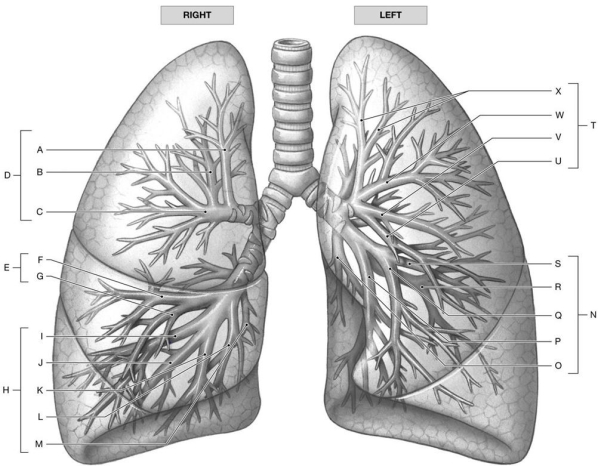A) because the gases are lipid-soluble
B) because the distance across the respiratory membrane is short
C) because the basement membrane of the alveolar epithelium is fused with the adjacent capillaries
D) because the the surface area of the blood-air barrier is large
E) All answer choices are correct.
Correct Answer

verified
Correct Answer
verified
Multiple Choice
Figure 24.1
 Identify the labeled structure(s) in each of the following questions.
-Identify the structure(s) indicated by Label G.
Identify the labeled structure(s) in each of the following questions.
-Identify the structure(s) indicated by Label G.
A) Pharyngeal tonsil
B) Palatine tonsil
C) Epiglottis
D) Oropharynx
E) Ary-epiglottic fold
Correct Answer

verified
Correct Answer
verified
Multiple Choice
Figure 24.1
 Identify the labeled structure(s) in each of the following questions.
-Identify the structure(s) indicated by Label C.
Identify the labeled structure(s) in each of the following questions.
-Identify the structure(s) indicated by Label C.
A) Laryngopharynx
B) Oropharynx
C) Nasal cavity
D) Nasopharynx
E) Glottis
Correct Answer

verified
Correct Answer
verified
Multiple Choice
Figure 24.2
 Identify the labeled structure(s) in each of the following questions.
-Identify the structure(s) indicated by Label X.
Identify the labeled structure(s) in each of the following questions.
-Identify the structure(s) indicated by Label X.
A) Anterior bronchopulmonary segment
B) Superior lingular bronchopulmonary segment
C) Medial basal bronchopulmonary segment
D) Inferior lingular bronchopulmonary segment
E) Apicoposterior bronchopulmonary segment
Correct Answer

verified
Correct Answer
verified
True/False
The lining of the trachea consists of respiratory epithelium overlying a layer of loose connective tissue called the lamina propria, which separates the respiratory epithelium from underlying cartilages.
Correct Answer

verified
Correct Answer
verified
Multiple Choice
Figure 24.1
 Identify the labeled structure(s) in each of the following questions.
-Identify the structure(s) indicated by Label H.
Identify the labeled structure(s) in each of the following questions.
-Identify the structure(s) indicated by Label H.
A) Oropharynx
B) Ary-epiglottic fold
C) Pharyngeal tonsil
D) Epiglottis
E) Palatine tonsil
Correct Answer

verified
Correct Answer
verified
Multiple Choice
Which of the following laryngeal cartilages are elastic cartilages?
A) cuneiform cartilages
B) arytenoid cartilages
C) cricoid cartilages
D) thyroid cartilage
E) corniculate cartilages
Correct Answer

verified
Correct Answer
verified
Multiple Choice
The respiratory membrane consists of all elements, except ________.
A) capillary endothelium
B) fused basement membranes
C) type I cell
D) type II cell
E) All of these elements are part of the respiratory membrane.
Correct Answer

verified
Correct Answer
verified
Multiple Choice
Filtration, warming, and humidification of inhaled air occur throughout the conducting portion of the respiratory system, but the greatest changes occur within (the) ________.
A) nasal cavity
B) oral cavity
C) pharynx
D) carina
E) larynx
Correct Answer

verified
Correct Answer
verified
Multiple Choice
Which hormone is involved with the regulation of blood volume and blood pressure?
A) angiotensin II
B) renin
C) erythropoietin
D) hydrolase
E) vasopressin
Correct Answer

verified
Correct Answer
verified
Multiple Choice
The left main bronchus divides into how many lobar bronchi?
A) one
B) four
C) five
D) three
E) two
Correct Answer

verified
Correct Answer
verified
Multiple Choice
Figure 24.1
 Identify the labeled structure(s) in each of the following questions.
-Identify the structure(s) indicated by Label D.
Identify the labeled structure(s) in each of the following questions.
-Identify the structure(s) indicated by Label D.
A) Palatine tonsil
B) Epiglottis
C) Pharyngeal tonsil
D) Ary-epiglottic fold
E) Oropharynx
Correct Answer

verified
Correct Answer
verified
Essay
A seventy-five-year-old smoker goes to his doctor complaining of shortness of breath and a chronic cough. He is relieved to discover that he does not have cancer; but he has been diagnosed with emphysema. What anatomical changes occur in the lungs of a person with this condition?
Correct Answer

verified
Emphysema is a chronic, progressive cond...View Answer
Show Answer
Correct Answer
verified
View Answer
Multiple Choice
Figure 24.2
 Identify the labeled structure(s) in each of the following questions.
-Identify the structure(s) indicated by Label A.
Identify the labeled structure(s) in each of the following questions.
-Identify the structure(s) indicated by Label A.
A) Anterior bronchopulmonary segment
B) Medial bronchopulmonary segment
C) Posterior bronchopulmonary segment
D) Apical bronchopulmonary segment
E) Lateral basal bronchopulmonary segment
Correct Answer

verified
Correct Answer
verified
Multiple Choice
The typical cell making up the alveolar wall is the ________.
A) type II alveolar cell
B) type I alveolar cell
C) alveolar macrophages
D) capillary endothelial cell
E) simple columnar cell
Correct Answer

verified
Correct Answer
verified
Multiple Choice
The connective tissues of the interlobular septa are continuous with which structure(s) ?
A) visceral pericardium
B) visceral pleura
C) parietal pericardium
D) parietal pleura
E) hilum
Correct Answer

verified
Correct Answer
verified
Multiple Choice
Figure 24.1
 Identify the labeled structure(s) in each of the following questions.
-Identify the structure(s) indicated by Label CC.
Identify the labeled structure(s) in each of the following questions.
-Identify the structure(s) indicated by Label CC.
A) Superior nasal concha
B) Epiglottis
C) Inferior nasal concha
D) Frontal sinus
E) Middle nasal concha
Correct Answer

verified
Correct Answer
verified
Multiple Choice
Regarding respiratory changes at birth, changes in blood flow that occur lead to the closure of the ________, the embryonic interatrial connection.
A) ductus venosus
B) foramen ovale
C) ligamentum arteriosum
D) foramen magnum
E) internal acoustic meatus
Correct Answer

verified
Correct Answer
verified
Multiple Choice
Each lung consists of approximately how many alveoli?
A) 100,000
B) one billion
C) 500,000
D) 150 million
E) 100 billion
Correct Answer

verified
Correct Answer
verified
Multiple Choice
Figure 24.1
 Identify the labeled structure(s) in each of the following questions.
-Identify the structure(s) indicated by Label L.
Identify the labeled structure(s) in each of the following questions.
-Identify the structure(s) indicated by Label L.
A) Thyroid cartilage
B) Glottis
C) Cricoid cartilage
D) Nasal vestibule
E) Hyoid bone
Correct Answer

verified
Correct Answer
verified
Showing 81 - 100 of 128
Related Exams